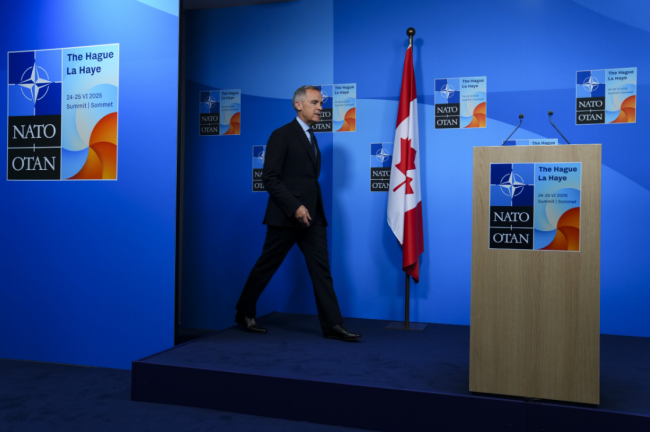Articles Menu

July 9, 2025
I have spent the past five years arguing that we need a “wartime” approach to confront the climate crisis. It seems metaphor is not our government’s strong suit – their imagination for a wartime approach is limited to, well, war.
For years, the climate movement has been calling on the federal government to spend two per cent of GDP on climate infrastructure and action. Likewise, the Climate Emergency Unit’s Marker #1 of genuine emergency action is to “spend what it takes to win.” But to no avail.
Tragically, if we had spent the last decade spending two per cent of GDP a year (or just over $60 billion in today’s dollars) on a just climate transition, we could have transformed the economy – our society would be unrecognizable in all the ways we aspire, and European jurisdictions would not be so embarrassingly kicking our ass when it comes to GHG reductions.
And yet, with disorienting ease, our new fiscally-conservative prime minister has announced that Canada’s military spending will hit two per cent of GDP this year, and will reach a stratospheric five per cent within 10 years – the largest increase in military spending since the Second World War – a target that will require additional spending of $50 billion to $90 billion a year (depending on how much the economy grows in that time). How on earth could such decisive military spending increases be made with such nonchalance, while it remains so damn hard to extract spending commitments to confront the climate crisis?
The campaign for a Youth Climate Corps has spent the last few years fiercely lobbying for a transformative new public program that would invite young people to mobilize in our collective defence, pressing for an initial investment of $1 billion a year. But we’ve constantly heard back that the government’s fiscal constraints make such an ask “unrealistic.” Yet when it comes to Donald Trump and NATO demanding that Canada up its military spending by an amount roughly 15 times larger this year alone, money is suddenly no object.
The Carney government’s decision to ramp up military spending will come with steep costs in other domains, not least because the government refuses to entertain tax increases (as I recently wrote about), despite the fact that we are facing an unprecedented economic attack from the Trump regime – normally in times of war, governments raise war taxes, particularly on the wealthy, but oddly not now.
For years, the climate movement has been calling on the federal government to spend two per cent of GDP on climate infrastructure and action, to no avail. And yet, Canada’s military spending will hit two per cent of GDP this year. Blue Sky
As former Liberal Foreign Affairs Minister Lloyd Axworthy (now a sharp critic of Carney) wrote in a recent Substack post: “Watch for a coming budget that slashes social programs and international aid to cover expanding military commitments — the unspoken cost of appeasement.”
The solutions to the climate crisis – mass electrifying our economy – are sitting on a political silver platter, waiting to be deployed at speed and scale. But instead, we have been subjected to painful incrementalism, a slow march towards decarbonization that is not only failing to bend the emissions curve at the pitch and pace required, but additionally keeps giving the fossil fuel industry time to regroup, forcing us to waste time and resources re-prosecuting fights we have already won. Witness the industry’s relentless efforts to roll back municipal prohibitions on gas use in new buildings, the auto industry’s recent efforts to repeal the zero-emission vehicle mandate, or the continuous efforts of industry to secure yet another fossil fuel pipeline or to stave off an oil and gas emissions cap. The climate movement ends up stuck in rear-guard actions in a deadly version of Groundhog Day.
Most maddening about the announced ramp-up in military spending is how it so grossly misconstrues the real security threat. I’m not a defence expert. I accept that we live in a dangerous world in which a growing list of regimes harbour expansionist and malicious intents. I suspect the most likely such threat we face is from a Trump-led USA, and no amount of military spending will protect us from that – if a southern assault is to be resisted, it will be by way of mass civil non-compliance. And it sure as hell means we shouldn’t be spending billions on a cockamamie “Golden Dome” missile defence system that leaves us locked in the house with that very same regime.
But there is now little doubt that the gravest security and civilizational threat we face is from the climate crisis itself – a threat multiplier at every level. As Ana Toni, the chief executive of the forthcoming COP30 UN climate conference in Brazil recently stated, “Climate is our biggest war. Climate is here for the next 100 years. We need to focus and … not allow those [other] wars to take our attention away from the bigger fight that we need to have.”
It is the climate crisis that is cooking people to death in record-breaking heat domes (as happened to over 600 British Columbians in the space of one week four years ago). As the Guardian recently reported, “Heat kills about 20 times more people than terror attacks and about six times more than war and armed conflicts.” It is the climate crisis that is displacing millions of people globally. It is the climate crisis that will wreak havoc with our food and water systems, and upend our healthcare system. It is escalating climate-induced wildfires and the burning of fossil fuels that is killing millions of people a year from air pollution.
Why must it be so bloody hard to spend what it takes to confront the real emergency?